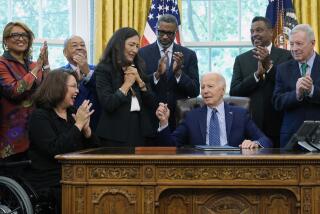Virginia’s D-Day Memorial Takes Disastrous Hit
- Share via
BEDFORD, Va. — The ceremony was glorious: With a sea of silver-haired veterans looking on, President Bush dedicated the National D-Day Memorial to honor those who died on the beaches of Normandy.
Now, just five months later, the foundation that runs the memorial is close to financial ruin. Its debt has ballooned to $7 million, the board has resigned, new construction has been curtailed, and at the request of the local prosecutor, the FBI and state police are investigating.
“It’s been a real shot in the gut,” said Bob Slaughter, a D-Day veteran who pushed for the memorial to be placed in this small farming community, which lost more soldiers per capita in the invasion than any other. Like many board members, Slaughter said he learned the extent of the problems only recently.
“We didn’t know that we owed anybody,” added Lucille Boggess, who stepped down as the board’s treasurer Oct. 11. Boggess said the financial reports she read every meeting were provided by the board president. “Many of us didn’t know what those reports meant.”
Her first inkling of trouble came April 27--a little more than a month before the dedication--when rumors circulated that Coleman Adams Construction Inc., a leading contractor on the memorial, was planning to quit. But nobody knew the exact amount the foundation owed.
“We had to continue building,” Boggess said. “We knew the president was coming and we had to get that plaza finished.”
By the time Bush arrived on the 57th anniversary of the June 6, 1944, invasion, the memorial was ready. Bronze statues of soldiers--some installed just days before--clawed across a concrete beach. An architectural representation of a troop boat sat in a shallow pool. Air jets shot mini geysers through the water to look like enemy fire. Above, a towering arch of polished granite stood, inscribed with the word “Overlord,” the Allied code name for the invasion.
Some D-Day veterans wept when they saw it for the first time.
How the memorial became so deeply in debt so quickly is a mystery to many involved with the foundation. But the problems likely started years ago, as community leaders pushed to build the memorial as fast as possible--breaking ground on construction projects sometimes before they had the money to pay for the work, said Richard Burrow, the foundation’s former president who resigned in July because of health problems.
“World War II veterans were dying, and the staff felt strongly that we needed to get this done as soon as possible,” Burrow said.
The memorial had accrued debts of “several million dollars” before, Burrow said, but donations always pulled the foundation out of trouble.
“But the big bucks we’d been receiving stopped coming in,” Boggess said. “Then the economy turned and the stock market went down. . . . Then we had the [Sept. 11] tragedy.”
Randy Krantz, the commonwealth’s attorney for Bedford County, would not comment on whether the board acted improperly. Krantz said he didn’t know when the state police and the FBI would finish their investigation of the foundation’s finances.
Kari F. Watkins, executive director of the Oklahoma City National Memorial, said she waited three years to collect $24 million from 4,000 donors and $5 million from Congress before breaking ground.
“We built a memorial that we knew we could afford,” Watkins said. “We don’t have any debt, and we’re not worried about it.”
Bill McIntosh, interim president of the National D-Day Memorial Foundation, said $5 million of the debt comes from construction projects, landscaping, sculptures, loans and the dedication ceremony, which alone cost about $500,000. The foundation also must pay back $2 million in donations promised for other projects that was borrowed to fund more immediate needs.
The new board, expected to be installed in November, likely will be more “national” in focus, bereft of the World War II and D-Day veterans who were the heart of the old board.
“I don’t know how much we’ll be missed,” Slaughter said. “But I’m very proud . . . bringing about something as magnificent as this. I just wish we could take away the last six months of 2001. Up until then, we were doing great.”
More to Read
Sign up for Essential California
The most important California stories and recommendations in your inbox every morning.
You may occasionally receive promotional content from the Los Angeles Times.












